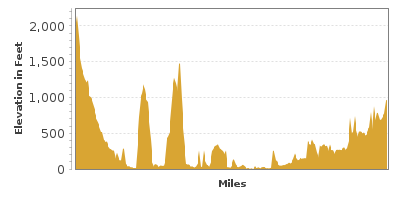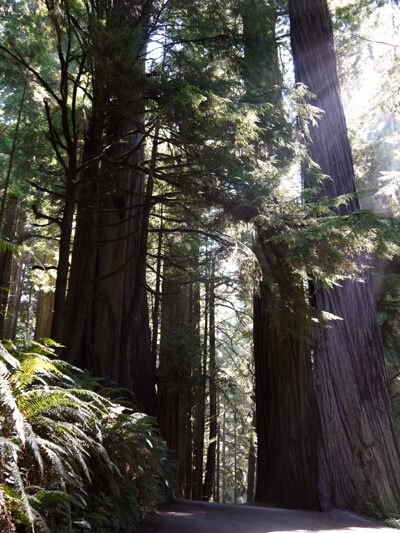Redwood Highway
Through the land of the giant Redwoods
| Mileage | 213 miles (344 km) |
|---|---|
| DurationThe duration is an estimate of a one-way drive and does not include any stops or side-trips. | 3 hours, 52 minutes |
| SeasonsThe seasons listed are the best seasons for this scenic drive. If Winter is not mentioned, the road may be closed during the winter. | All Seasons |
| Roadways | US Highways 101 and 199 |
| PassesSome of the adventures on this scenic drive require an admission fee that these passes cover. Please read the drive description for more information. | America the Beautiful Annual National Parks Pass 2025-2026 |
| ServicesThe cities or towns listed have either Food or Services such as gas, pharmacies, etc. | Smith River, CA▼, Crescent City, CA▼, Klamath, CA▼, Trinidad, CA▼, McKinleyville, CA▼, Arcata, CA▼, Blue Lake, CA▼, Eureka, CA▼, more...Fortuna, CA▼, Ferndale, CA▼, Myers Flat, CA▼, Miranda, CA▼, Redway, CA▼, Garberville, CA▼, Gasquet, CA▼, Hoppaw, CA▼, Klamath Glen, CA▼, Riverside Park, CA▼, Englewood, CA▼, Weott, CA▼, and Leggett, CA▼ |
| Rating | 4.0 average from 160 votes |
| My DrivesTrack your favorite scenic drives by selecting those which you want to take and those that you have taken. Using your free account, simply sign in and select My Drives. | |
| Share |
Our free Road Trip Planner will reverse the route and include the places of interests. Click the “Add to Road Trip” above to start planning your next road trip.
Send this link to your phone. Standard text messaging rates apply.
() -Get directions from your start address to the beginning of and including this scenic drive. Choose either an alternate ending or same as start.
Have more destinations? Use our free Road Trip Planner to completely plan your adventure. Click the “Add to Road Trip” above to start planning your next road trip.

Get a Park Pass
Natural areas along this route require an entrance fee used to protect and maintain our most scenic treasures. Save time by purchasing your forest passes before you go.
The Redwood National Forests protect almost half of the remaining old growth, coastal redwood forests in the world, and is home to one of the tallest trees on Earth. Experiencing the nine stops of the Avenue of the Giants (T1) is an absolute must.

This drive starts at the Oregon border on US-199 and travels south until it joins the US-101 for a coastal scenic drive. Heading south on US-101, our drive ends in Leggett. Reaching the US-199 from Oregon is easily done from the Rogue-Umpqua Scenic Byway or it is a short drive from the US-101 from the Oregon Coast.
The Rogue River and Siskiyou Forests surround you as the journey begins south on US-199, the Smith River Scenic Byway. In a few miles, you will drive through the Collier Tunnel through Oregon Mountain.
The road twists and turns. As you join the Smith River, the view opens up a bit and the Siskiyou Mountains are exposed along the roadside. A few more miles, the forest forms a canopy so thick that the temperature cools down quickly.
Stop at the Gasquet Ranger Station (I1) for information regarding some of the local hikes, including the popular 14-mile South Kelsey Historical Trail, the 4-mile Craig’s Creek Trail, the 2.5-mile Doe Flat Trail and 1-mile Myrtle Creek Trail which features interpretive signs about the plants, geology and mining history of the area.
The Redwood Highway may seem like a misnomer at the beginning of the drive, but in 20-miles these giants will lure you out of your car for a closer inspection. Explore the Simpson-Reed Grove (H14), a short 1-mile interpretive trail amongst these giants.
You are now within the Jedediah Smith Redwoods State Park (H1), which protects more than 10,000 acres of giant Redwoods. Several miles of trails head through this park to access these majestic trees. The park also provides access to the Smith River, which divides the park in half. The tallest Redwood within the park is in the Stout Memorial Grove, at 340 feet high and a diameter of 22-feet. You can get to Stout Grove by taking the unpaved but well-maintained Howland Hill Road. This two-way narrow road winds through the forest with pull-outs and hiking trails such as the Boy Scout Tree Trail and Stout Grove Trail which offer the chance to get close to these magnificent wonders. This road is not advised for motorhomes/RVs and trailers.
Continuing west on US-199, you will soon join the US-101 highway. Heading north will bring you to The Oregon Coast, but for this drive, we continue south towards Crescent City.
In Crescent City, the beaches are some of the most accessible along the drive. Find a parking spot, jump out of the car, and walk down to the sandy beach. If you’re looking for a more secluded spot, don’t miss Enderts Beach. A half-mile walk down is rewarded with a glorious expansive beach and rocky outcroppings that are home to colorful tidepools and the bobbing heads of seal lions and seals. The water is cold (as for most of the Oregon coast) but the brave will delight in the powerful crashing waves. If you are visiting during spring, Crescent City is also well-known for its Easter lily farms.
As you continue south on US-101, the road switches back from freeway-style roads to romantic country roads, providing wonderful views of the surrounding nature.
While you cannot see many Redwoods from the Highway, the next several miles of US-101 heads through parks which contain most of the remaining Giant Redwoods in the world. The Del Norte Coast Redwoods State Park (H2) and Prairie Creek Redwoods State Park (H3) offer hikes through old-growth forest and along their wild coastline.
As you continue south on US-101, the Redwood National Park (H4) is a treasure of ancient, giant coastal redwoods and their ecosystems, including black bears, Roosevelt elk, and marbled murrelets forming one of the world’s most extraordinary forests. There are many entrances to this park, but we recommend Bald Hills Road which twists through the Bald Hills and near the Lady Bird Johnson Grove or the Newton B. Drury Scenic Parkway.
Further south on US-101, Humboldt Lagoons State Park (H5) is a marshland habitat that supports a wide variety of plants, birds, and other animals. The park is situated on the Pacific Ocean beach making it ideal for bird watchers and beachcombers alike.
The next stretch of road travels along the Pacific Ocean and the parks in this region all provide beach access. Trinidad State Beach (W2) is one of the more popular destinations due to the unusual rock formations, bluffs for hiking and seasonal whale and sea lion watching.
If you are traveling through this area during the Spring, stop at the Azalea State Reserve (H7) for a picnic or walk as the western azaleas will be in bloom, their scents filling the air.
A few miles south of Eureka you will enter Humboldt Bay, where the Humboldt Bay National Wildlife Refuge (H8) protects the wetland homes frequented by black brant, ducks, geese, swans, and other birds.
The drive now leaves the Pacific Coast and back through forests. In 22-miles, you will see a sign for the Avenue of the Giants (T1). This 33-mile stretch of road runs parallel to the US-101 and through dense forests of Coastal Redwoods. The road twists and turns around these giants with plenty of places to stop and explore. At the beginning of the road, there is a stop describing the 9 recommended highlights. As you travel, there will be many signs leading to the US-101, ignore them and keep heading south on Avenue of the Giants until the true end.
The Avenue of the Giants is part of the Humboldt Redwoods State Park (H9), the third largest state park in California, and with 17,000 acres of Redwoods is the largest remaining old-growth Redwood forest in the world. While the Avenue of the Giants provides a taste of these giants, explore the park’s many trails to truly appreciate their magnitude.
As you continue the journey south on US-101, Benbow Lake State Park (H10) is just a few miles from Gaberville and has a beautiful lake formed by the creation of a dam in the 1950s. The park is ideal for fishing, hiking, and picnicking.
If you are already missing the giant redwoods, Richardson Grove State Park (H11) is home to the 9th tallest coast redwood and you can enjoy hiking near or swimming in Eel River.
In 13-miles, you arrive at the Standish Hickey State Recreation Area (H13), which similar to Richardson Grove State Park, has a patch of Redwoods and lies on the banks of Eel River.
Our Redwoods scenic drive ends in Leggett. From here, continue south on down the Northern Pacific Coast or zoom back up the highway and continue north on the US-101 to The Oregon Coast.
Other Nearby Places of Interests
Sinkyone Wilderness State Park (H12): Sinkyone Wilderness State Park is sometimes referred to as the “Lost Coast” because highways do not go through it, but for explorers, this no-services park features camping, fishing, hikes, biking, horseback trails, and picnic areas.
Patricks Point State Park (H6): Patricks Point State Park features a dense forest hanging over the Pacific Ocean. Explore the sandy beaches and hike through the forest.
Clarke Memorial Museum (M1): The Clarke Memorial Museum preserves the history of the early settlers to this area, including Victorian clothing, furniture, glassware, and more.
Humboldt Bay Maritime Museum (M2): Humboldt Bay Maritime Museum celebrates the early settlers of the Northern Coast of California.
Blue Lake Museum (M3): The Blue Lake Museum features the local history of railroading and logging through these parts. The museum is open during the summer and by appointment-only during the off season.
Walker Road (T2): Part of the Jedediah Smith Redwoods State Park, the 1-mile, gravel Walk Road heads through the forest and to the Smith River.
Howland Hill Road (T3): Howland Hill Road heads through a canopy of redwoods and travels between Hiouchi and Crescent City. From Hiouchi, turn south (left) onto Country Road 427, crossing the Smith River twice, until the Douglas Park Drive is on your right which begins this beautiful road.
Klamath River Overlook (V1): A short side-trip on Requa Road will bring you to the Klamath River Overlook, where California’s second largest river dumps into the Pacific Ocean.
Little River State Park (W3): Little River State Beach features dunes and public beach access.
Clam Beach County Park (W4): Clam Beach County Park has beach access and camping sites.




